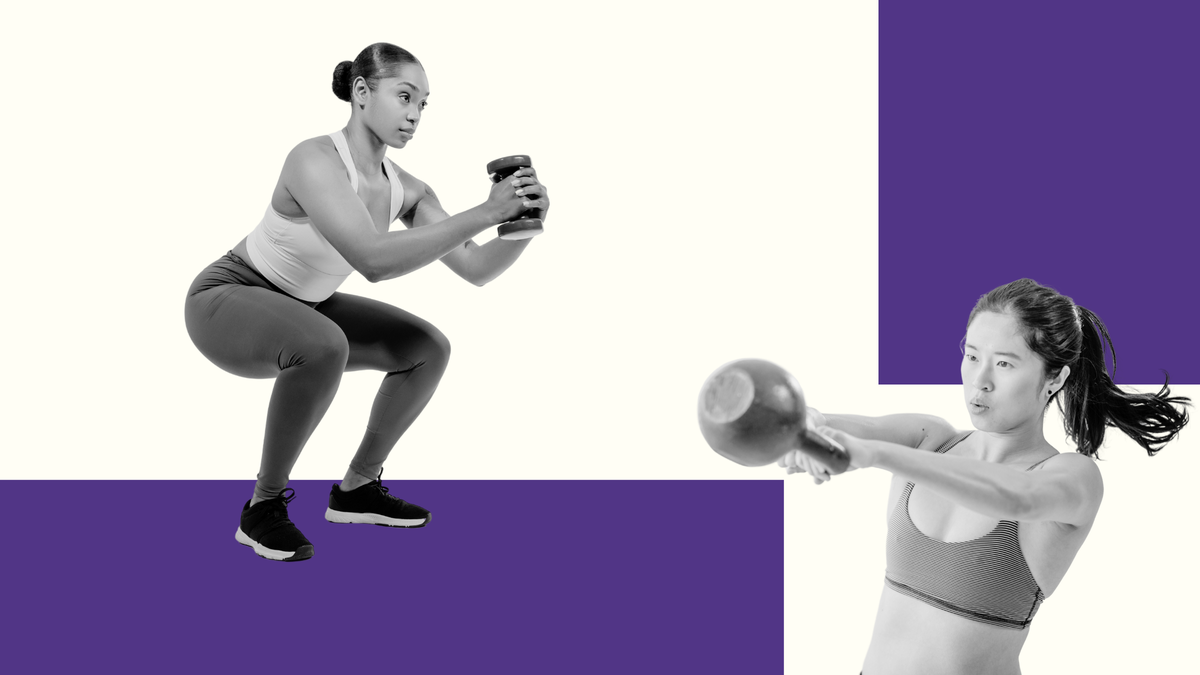
For classes, camaraderie, and the latest equipment, you can’t beat the gym. But for those times when you don’t want to make the commute, have a packed schedule, or just want to get your session in without having to jockey for space by the dumbbell rack, you can get a full-body workout at home with just a few pieces of well-chosen strength training gear.
With a set of adjustable weights, resistance bands, and a raised platform, you can reap all the same benefits of a gym workout—improved cardiovascular health, increased muscle mass, and greater mobility—while enjoying a cleaner environment and zero wait times for your favorite piece of equipment.
How to Build a Strength Training Set-Up at Home
One key to building an effective home gym is determining how much space you have to work with. A jump rope, for example, will only be effective for building cardiovascular fitness if you have enough space to spin the rope without hitting the ceiling, walls, or a piece of furniture. You can get most of the benefits by doing the same jumping exercise without the rope itself.
A barbell and plates are fantastic for building strength, but if you live in a small apartment, that takes up a lot of precious space (and deadlifting might bug your downstairs neighbors). A dumbbell or kettlebell can be a worthy substitute.
Anything that provides resistance, from weights to elastic bands, can be an effective tool for muscle building, strength, and endurance training. With a set of bands in varying weights, you can mimic weighted exercises, including squats, push-ups, planks, and rows. To make a move more challenging, you can add reps, change the tempo of your movement (slowing down the lowering phase or adding a pause at your end range), or decrease your rest time between sets.
Strength Training Tips
If any of these exercises are new to you, start light and slow. Here are some tips to make sure you get the most out of your at-home training.
Don’t Automatically Go for the Heaviest Weight
To avoid injury and maximize the impact of your workout, ensure you’re moving with proper form, using a weight you can handle. Reach for the lightest option and try to perform six to eight reps. On a scale of one to ten, your perceived level of difficulty should be about around a seven. If it’s lower, try a heavier weight; if it’s higher, scale down.
For the kettlebell moves, instead of buying a set of kettlebells, go for one that’s a little heavier than your usual working weight and start with lower reps and longer rest times. To get the most out of your kettlebell, consider purchasing an adjustable kettlebell so that you can increase or lower the weight as needed.
Create a Goal and Stick to It
Focusing on a goal will help you determine the structure of your reps, sets, and rest time. For building strength, aim for three to six sets of one to five reps, with two to five minutes of rest to recover between each set. Your working weight should be 80 to 100 percent of your one-rep max, or the most you can lift for a single rep.
If your goal is to build more muscle mass, try three to six sets of eight to 12 reps, with one to two minutes of rest between sets. Your working weight should be 60 to 85 percent of your one-rep max.
Looking to increase your time-to-fatigue on your runs, rides, or swim sessions? You’ll want to work on building muscular endurance. To do that, aim for three or four sets of twelve or more reps, with 30 seconds of rest in between sets. Your working weight should be 60 to 75 percent of your one rep max.
4 Essential Pieces of Strength Training Equipment (And How to Use Them at Home)
If you’re just starting out with at-home workouts, you don’t need to purchase a lot of equipment. Here are a few of our favorite space-saving items and some of the movements you can try with each of them.
1. Adjustable Dumbbells
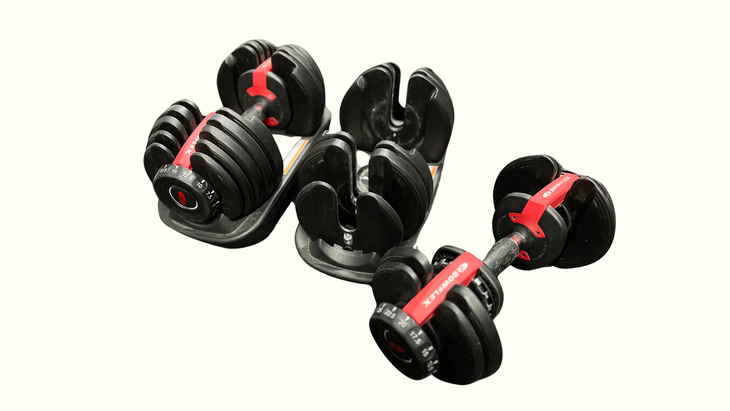
At the start of the pandemic, adjustable dumbbells were among the most difficult pieces of equipment to find, and with good reason: they’re the most versatile resistance training equipment. You can train bilaterally or unilaterally, effectively training both the upper and lower body. You can change the level of difficulty as you increase your strength and skill.
Goblet Squat
To perform this variation of a squat, turn a single dumbbell so it’s vertical and grasp it with two hands under one end. Separate your feet so they’re shoulder-width apart. Keeping your torso upright, bend your knees and lower your hips towards the floor at the same time. Pause for a moment at the bottom. Brace through your core, press your knees out to the sides, and stand up, keeping your torso upright. That’s one rep.
Floor Press
For a floor press, begin seated on the floor, knees bent and feet flat on the ground, holding one dumbbell in each hand. Roll back so your torso is now on the ground, with your arms straight, directly over your chest. Slowly lower the weights towards your chest, stopping when your bent arms touch the floor. Press your arms back up over your chest. That’s one rep.
You can perform these with elbows bent away from your body to focus on your pecs or with elbows tucked into your torso to focus on your triceps.
2. Kettlebells
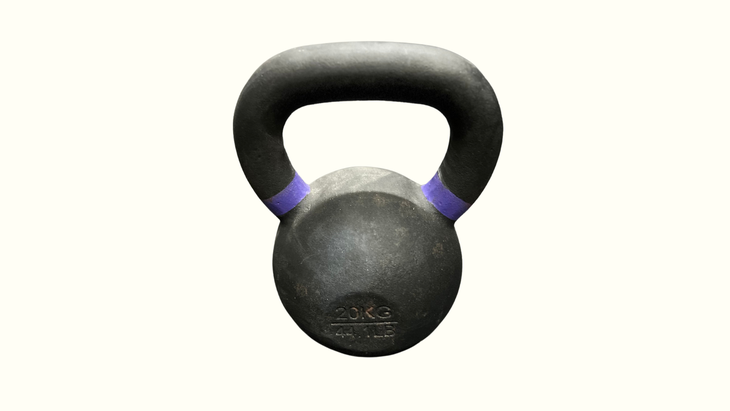
If you’re looking for one tool to improve your total-body strength, power, and force production, reach for a kettlebell. It can be used in place of a dumbbell for any strength exercise (squats, overhead press), but because of the uneven weight distribution, it can also be used to blend strength and cardio into a single movement. The kettlebell swing, in particular, has been shown to increase maximum and explosive strength as well as cardiorespiratory fitness.
Swing
Start your swing by placing a kettlebell on the floor. Stand about two steps away, facing the kettlebell, with feet shoulder-width apart. Bend at the knees and hinge at the hips, reaching forward to grab the handle of the kettlebell with both hands. Look straight ahead, maintain a flat back, and swing the kettlebell through your legs and behind you with arms straight. As soon as the weight is behind your legs, thrust your hips forward, swinging the weight to chest height. Hinge at the hips as you swing the bell back behind your legs again. That’s one rep.
Half-Kneeling Single-Arm Press
A half-kneeling single-arm press starts with a low lunge. Begin on the floor with one leg bent in front of you with your foot flat on the floor and the other behind you with your shin and the top of your foot on the floor. Your kettlebell should be on the same side of your body as your back leg. Reach down, grab the handle with one hand, and bring it to your shoulder. Brace your core and press the weight overhead. That’s one rep. (If you’re sinking into the hip of the back leg or if your torso is twisting to one side, the weight is too heavy.)
3. Resistance Bands
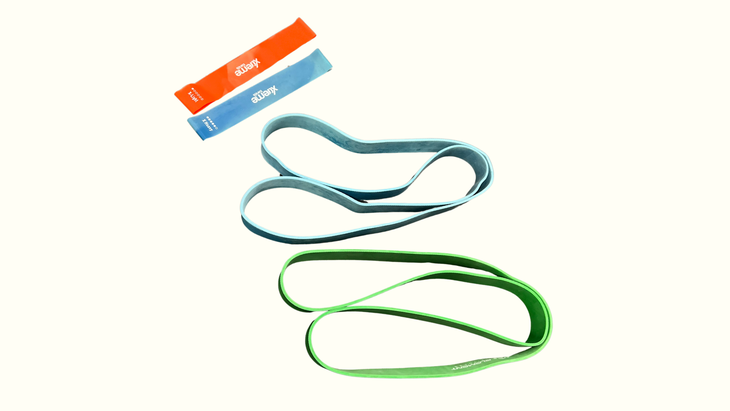
You can get an effective strength workout even without weights. Resistance bands, which often come in a pack of various levels of thickness and in mini or long versions, are inexpensive and easily transported or stored. Because the bands themselves are light, the risk of injury from doing a move incorrectly is lower, making them beginner-friendly.
Banded Clam Shells
To execute a banded clam shell, pull a small elastic over both legs, placing it just above your knees. If you’re using longer bands, double-loop the lightest band and place it on the same spot. Lie on one side of your body, knees bent and the inside of your feet touching. Keeping the insides of your feet in contact the entire time, slowly open your top knee towards the ceiling, then slowly lower it back down. That’s one rep.
Upright Rows
For upright rows, stand on the open loop of a long resistance band with your feet hip-width apart. Hold the opposite end with your hands, palms facing down. Pull up on the band, bending your elbows out to the sides. Draw the band all the way up to your chin, pause, then lower back to the start. That’s one rep.
4. A Box or Bench
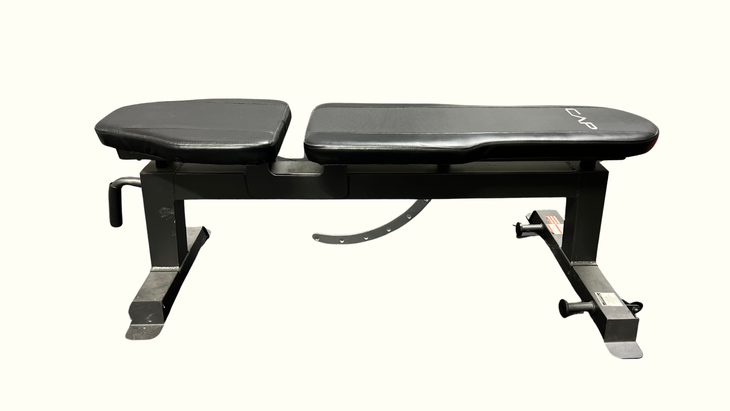
A box or a bench can help you regress or progress a challenging movement. For example, a pushup on the floor, even on your knees, can be too much for someone new to strength work. You can work up to that exercise by elevating your torso with your hands on a platform.
When you need a bigger challenge, you can increase the difficulty by having your toes on the platform and your hands on the floor. Benches usually come in two options: flat or adjustable (this one folds up to save space). Adjustable is a bit more versatile for dumbbell movements.
Step-Ups and Step-Downs
You can do a box step with or without weights. If you’re using weights, hold a light dumbbell in each hand. Engage your core and step onto the box or bench with one leg, allowing the other leg to hover just behind the edge of the platform. Pause, re-engage your core, and slowly lower your hovering leg to the floor. That’s one rep. Keep the other foot on the platform, press your foot into the platform, and raise the back foot again to keep moving through the reps.
Push-Ups
To do a push-up, place your hands on the box or bench, about shoulder-width apart. Step back with both feet until your body is in a plank position. Bending your elbows out to the sides, slowly lower your torso towards the platform. Pause with your torso just above the platform, then press through your hands to return to the top. That’s one rep.
Want more of Outside’s Health stories? Sign up for the Bodywork newsletter.
The post Everything You Need to Get a Scalable Strength Workout at Home appeared first on Outside Online.















